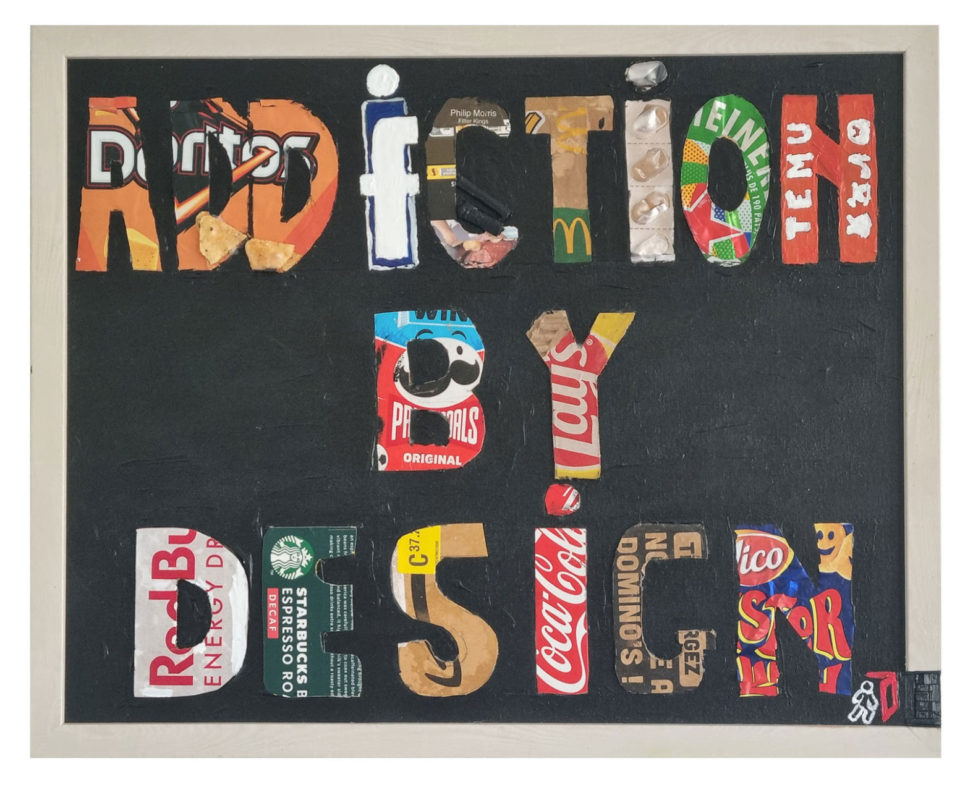Artwork title: alt+f4
Author: Gringo
Created: circa 2024
Size: 52 cm x 42 cm
Materials: Acrylic, brand logos collected in public trash cans and acrylic varnish on synthetic wood.
This work is titled “alt+f4”, evoking the Windows shortcut to stop a program, and serves as a powerful visual and conceptual metaphor to introduce reflection on the little-known concept of “addiction by design” explored by Natasha Dow Schull , in her book “Addiction by Design ” (Princeton University Press, 2012).
Just as “alt+f4” represents an intentional act of interrupting an ongoing process, “addiction by design” describes how products and services are created to keep us continually engaged , often in ways that make it difficult to stop that interaction.
The key for you, as citizens, is to be aware of this possibility. Ask yourselves:
- Is this product or environment designed for continuous use?
- Do I feel a need or urgency to continue interacting with him, even when it is not rational or productive?
- Are sensory elements or rewards being used to keep my attention?
- Is my data being collected to influence my behavior?
Just as Darlene, one of the people interviewed in the research, sensed that “something sinister” was at play in the design of slot machines, it is crucial to develop a critical awareness of how products and environments are designed to influence our behaviors and potentially encourage unhealthy or addictive habits.
It’s not about blaming a particular industry, but rather about understanding the forces that shape your everyday experiences and exercising your autonomy in a world increasingly designed to capture and hold your attention. Being informed is your best defense against “addiction by design.”
Addiction by Design
This concept, detailed in Schull’s research, particularly in his study of slot machine play in Las Vegas, reveals how meticulous design seeks to encourage prolonged engagement and repetition, sometimes leading to a state of uninterrupted immersion.
The author of the artwork choice of the title “alt+f4” for the artwork aligns directly with her warning. In a world where technology is increasingly designed to hold our attention and modulate our behavior, the action of pressing “alt+f4” becomes an individual act of resistance , a conscious decision to disengage from designed feedback loops and retention mechanisms. Her work invites citizens to reflect on whether they are interacting with technologies out of autonomous choice or by the subtle force of persuasive design, and whether an “alt+f4” is ever necessary in their own digital lives.
Below is an important caveat regarding “addiction by design” and the evolution of tracking, taking into account the views of Natasha Dow Schull:
This work aims to issue a fair warning about a concept that is increasingly present in the design of products and services across various industries: “addiction by design.” We expand on this warning to consider Natasha Dow Schull’s perspectives on tracking and self-monitoring, elements intrinsically linked to how we seek to maintain our engagement with different products and services.
Definition and Origin of the Concept, with the Perspective of Natasha Dow Schull
” Addiction by design” is the principle that certain products and environments are deliberately designed with features and functionality that encourage prolonged engagement and repetition, which can lead to habits that are difficult to break and, in some cases, addiction.
This concept has been extensively researched in the context of the gambling industry, particularly in relation to slot machines in Las Vegas, as documented in Natasha Dow Schull’s book “Addiction by Design: Machine Gambling in Las Vegas” . Schull, in her research, delved into how the design of gaming machines and casino environments are meticulously crafted to foster a state of immersion (“the zone”) through continuous interaction and sensory manipulation, with the aim of keeping players in a desubjectified state of uninterrupted movement in order to capitalize on their affect .
Schull notes that his initial research on casinos revealed intensive behavioral tracking systems that, in many ways, preceded the capabilities of companies like Amazon and Google. This real-time tracking and response to consumers seeking “continuous gaming productivity.”
Application of the Concept in Various Industries and Schull‘s Perspective
Drawing on Schull’s research, it’s possible to identify how other industries might also be leveraging similar concepts to create interactive loops, sustain attention, and potentially make their products and experiences more “addictive” in the sense of continued engagement and repeat purchases.
The overall goal is to maximize consumer engagement and encourage repeat consumption.
Schull invites us to consider how this self-policing trend aligns with the “addiction by design” logic he observed in casinos.
Here’s how the general principle of addiction by design applies across industries, incorporating Schull’s insights on tracking and self-monitoring:
- Food Industry: Similar to casino design, which seeks to minimize friction and maximize immersion, the food industry could employ convenience, accessibility, and gratifying flavor design to encourage repeat consumption by minimizing the “friction” between craving and consumption. Schull, while not directly focusing on food, highlights how technologies seek to supplement our own intuition about basic aspects of life which could extend to how we perceive our food needs, influenced by food design and marketing.
- Social Media Apps (TikTok, Facebook, Instagram, X, among others): These platforms employ immediate feedback (likes, comments), variable reward systems (notifications), personalized content through algorithms, infinite scrolling, and the sense of not missing a thing to continuously maintain user attention.Schull describes how self-monitoring technologies also use algorithms to reveal insights and inform interventions in future behavior. The logic of keeping the user immersed and engaged resembles the “structured confusion” of casinos that Schull described, where distractions are minimized to maximize focus on the platform .
- E-commerce platforms (Temu, Alibaba, Amazon, among others): These platforms use algorithmic personalization, gamification of purchases (discounts, offers), constant product updates, and minimization of friction in the purchasing process to encourage continued attention and repeat purchases. Similar to how casinos track and respond to player behavior, these platforms analyze data to optimize recommendations and the user experience, seeking to maintain a continuous flow of interaction and purchases.
- Pharmaceutical Industry: The conception of health as a state requiring continuous modulation through medical-technological interventions can lead to long-term dependence on certain medications. Schull mentions how pharmaceutical companies see self-monitoring technologies as a way to improve medication adherence. This aligns with the trend toward automation of self-care that Schull observes, where regulation becomes a function of algorithms and devices.
Natasha Dow Schull‘s Warning: From “Compass” to “Thermostat”
A crucial point Schull introduces is the evolution of tracking technology from a “compass” that offered self-awareness and perspective to a “thermostat” that seeks automatic intervention and regulation. This shift entails a diminished need for self-reflection and intentional action, outsourcing the responsibility for self-regulation to algorithms and devices.
Schull cites examples of technologies such as headphones that adjust music based on heart rate or apps that send alerts to eat or drink, illustrating this trend toward self-care automation.
Critical Consciousness and Autonomy
It is essential that citizens develop a critical awareness of how the products and environments around them might be designed not only to hold their attention, but also to collect data and potentially influence their behaviors in ways that erode autonomy.
Natasha Dow Schull’s research provides a valuable framework for understanding the duality of tracking and the need to navigate this complex reality with information and discernment. Being informed and reflecting on our motivations and the potential impacts of using these technologies is crucial to exercising our autonomy in a world increasingly mediated by design and data.
Sources consulted
- Schüll, Natasha Dow. Addiction by design: machine gambling in Las Vegas. Princeton University Press, 2012.
- YouTube: Databite No. 75: Natasha Schüll (1:03:33) https://www.youtube.com/watch?v=NDlQu1ow_0s


Leave a Reply